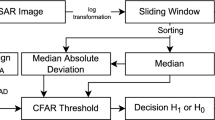Abstract
Automatic detection of ship targets from synthetic aperture radar (SAR) images is an important and challenging problem. Given the different nature of target returns in homogeneous and heterogeneous regions in SAR imagery, conventional detection algorithms fail to yield automatic and robust results. In support of automatic vessel monitoring, an adaptive detection framework designed for detecting ships from SAR imagery is proposed in this paper, and the variance weighted information entropy is introduced into the framework construction. Experimental results indicate that the proposed method can effectively detect the ship targets from various circumstances without any prior knowledge.





Similar content being viewed by others
References
Brusch, S., Lehner, S., Fritz, T., et al.: Ship surveillance with terrasar-x. IEEE Trans. Geosci. Remote Sens. 49(3), 1092–1103 (2011)
Eldhuset, K.: An automatic ship and ship wake detection system for spaceborne SAR images in coastal regions. IEEE Trans. Geosci. Remote Sens. 34(4), 1010–1019 (1996)
Jiang, Q.S., Aitnouri, E.M.: Ship detection in radarsat SAR imagery using PNN- model. Can. J. Remote Sens. 26(4), 297–305 (2000)
Amir, Z., Yaser, N.: Automatic dual censoring cell-averaging CFAR detector in non-homogenous environments. Signal Process. 88(11), 2611–2621 (2008)
Gao, G., Liu, L., Zhao, L.J., et al.: An adaptive and fast CFAR algorithm based on automatic censoring for target detection in high-resolution SAR images. IEEE Trans. Geosci. Remote Sens. 47(6), 1685–1697 (2009)
Ji, Y.G., Zhang, J., Meng, J.M.: A new CFAR ship target detection method in SAR imagery. Acta Oceanol. Sin. 29(1), 12–16 (2010)
Kuo, J.M., Chen, K.S.: The application of wavelets correlator for ship wake detection in SAR images. IEEE Trans. Geosci. Remote Sens. 41(6), 1506–1511 (2003)
Yang, L., Zhou, Y., Yang, J., et al.: Variance WIE based infrared images processing. Electron. Lett. 42(15), 857–859 (2006)
Li, Y., Mao, X.J., Feng, D., et al.: Fast and accuracy extraction of infrared target based on Markov random field. Signal Process. 91(5), 1216–1223 (2011)
Yang, L., Yang, J., Ling, J.: New criterion to evaluate the complex degree of sea-sky infrared background. Opt. Eng. 44(12), 126401–126406 (2005)
Cao, Z. J., Ge, Y. C., Feng, J. L.: Fast target detection method for high-resolution SAR images based on variance weighted information entropy. EURASIP J. Adv. Signal Process. 1 (2014)
Huang, S.Q., Liu, D.Z., Gao, G.Q.: A novel method for speckle noise reduction and ship target detection in SAR images. Pattern Recog. 42(7), 1533–1542 (2009)
Author information
Authors and Affiliations
Corresponding author
Rights and permissions
About this article
Cite this article
Wang, X., Chen, C. Adaptive ship detection in SAR images using variance WIE-based method. SIViP 10, 1219–1224 (2016). https://doi.org/10.1007/s11760-016-0879-4
Received:
Revised:
Accepted:
Published:
Issue Date:
DOI: https://doi.org/10.1007/s11760-016-0879-4




